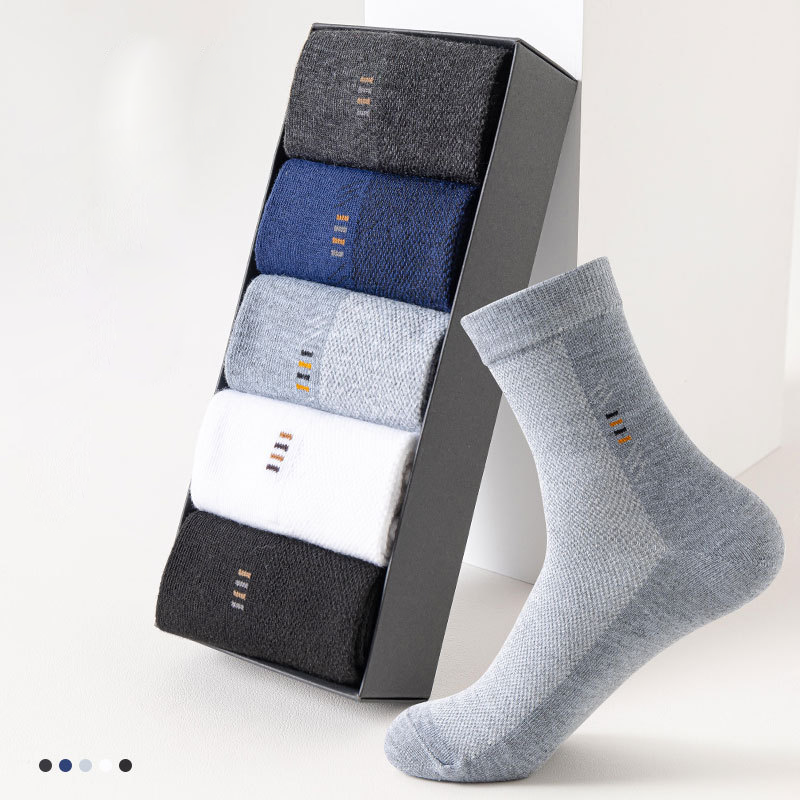

Socks may seem like a minor detail in a man’s wardrobe, but they play a crucial role in both style and comfort. The right pair of socks can complement your outfit, keep your feet comfortable throughout the day, and even express your personal taste. For modern men, understanding the differences between formal and casual socks—and how to select the best types for each occasion—is key to achieving a polished and confident look.
This article explores the main categories of men’s socks, the materials and designs suited for different settings, and how to choose socks that balance both fashion and functionality.
Socks do more than just protect feet from friction and absorb sweat. They also serve as an essential accessory that bridges the gap between shoes and trousers, ensuring both hygiene and style.
For formal settings, socks should complement the suit and shoes, maintaining a sleek, cohesive look. For casual wear, however, socks can be a statement piece, offering room for colors, patterns, and textures that reflect personality and creativity.
The challenge lies in knowing which type works best for each situation—and how to wear them confidently.
Formal socks are typically worn with dress shoes and suits in business, professional, or ceremonial environments. The key attributes are subtlety, elegance, and coordination.
1. Dress Socks
Dress socks are the foundation of formal menswear. Usually made from fine materials like merino wool, cotton blends, or silk, they are thin, breathable, and fit snugly without bulk.
2. Business Casual Socks
For semi-formal or business-casual workplaces, you can opt for socks with more variety in texture or color. Subtle patterns—like stripes, polka dots, or small geometric shapes—add a touch of personality without breaking professionalism.
3. Luxury Formal Socks
Made from high-end materials like silk or cashmere, these socks are ideal for events like weddings, galas, or black-tie occasions. Their fine weave and sheen elevate the entire look, especially when paired with patent leather or oxford shoes.
Casual socks allow for more freedom of expression in both design and material. Comfort, breathability, and personality are the focus here.

1. Crew Socks
Crew socks are among the most versatile and commonly worn types. They reach mid-calf and work well with jeans, chinos, or casual trousers.
2. Ankle Socks
Ankle socks sit just above the shoe line and are ideal for sneakers, trainers, or loafers. They’re perfect for a sporty or summer-casual look.
3. No-Show Socks
No-show or invisible socks give the illusion of going sockless while keeping your feet protected. They’re essential for pairing with loafers or slip-ons in warmer months.
4. Wool or Thermal Socks
For cold-weather casual wear, wool socks provide warmth and insulation. These are ideal for outdoor activities, boots, or hiking. Merino wool versions are particularly popular for their odor resistance and comfort.
5. Patterned or Colorful Socks
In casual environments, socks can serve as a fashion statement. Bold prints, color-block designs, or themed graphics reflect individuality and add character to an outfit.
The fabric composition of socks directly affects comfort, durability, and breathability. Here are some common materials used for men’s socks and their characteristics:
| Material | Best For | Characteristics |
| Cotton | Everyday wear | Soft, breathable, and affordable |
| Merino Wool | Year-round comfort | Moisture-wicking, odor-resistant, temperature-regulating |
| Silk | Formal occasions | Smooth texture, elegant appearance |
| Nylon/Polyester Blends | Sports and durability | Stretchable, quick-drying, long-lasting |
| Cashmere | Luxury or winter wear | Extremely soft and warm |
| Bamboo Fiber | Eco-conscious choice | Naturally antibacterial, soft, and moisture-absorbent |
Selecting the right material depends on your activity level, climate, and personal comfort preference. For instance, merino wool socks are ideal for long office hours or travel because they regulate temperature and reduce odor, while cotton socks suit daily casual wear.
Formal Matching Rules:
Casual Matching Rules:
Ill-fitting socks can ruin comfort and appearance. Here’s what to look for:
For dress socks, a snug fit ensures a sharp silhouette without excess fabric bunching around the ankle. For casual or athletic socks, slightly cushioned soles improve comfort and shock absorption.
Proper care extends the lifespan of your socks and keeps them looking fresh.
Replacing socks regularly is also essential; worn-out pairs can affect both comfort and foot hygiene.
High-quality socks can significantly improve comfort and style, especially for men who spend long hours on their feet. Investing in premium brands made from merino wool, Egyptian cotton, or bamboo can reduce odor, prevent blisters, and enhance overall appearance.
Luxury socks often feature hand-linked toe seams, reinforced heels, and precise sizing—all indicators of craftsmanship. While they cost more upfront, they tend to last longer and provide a superior wearing experience.
Modern men’s fashion embraces individuality, even in small details like socks.
Current trends include:
Socks might be small, but they make a big impact on comfort, hygiene, and style. For formal occasions, classic dress socks in dark, smooth fabrics maintain a refined, professional image. For casual wear, crew, ankle, or no-show socks allow greater creativity, comfort, and versatility.
Choosing the right socks is about balancing function, fashion, and fabric—ensuring your feet feel good and your outfit looks complete. Whether you’re dressing for the boardroom or the weekend, the perfect pair of socks can elevate your look from ordinary to exceptional.